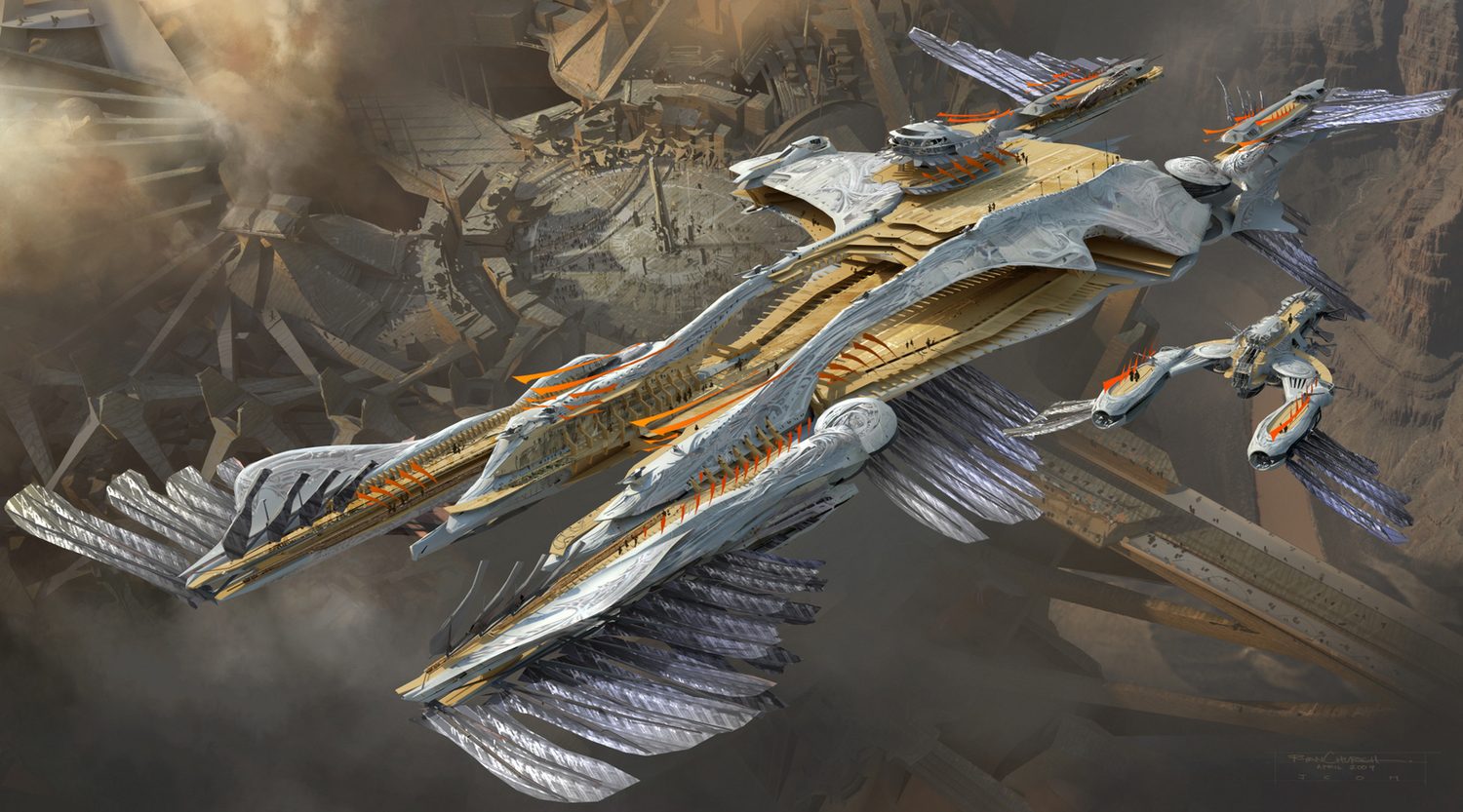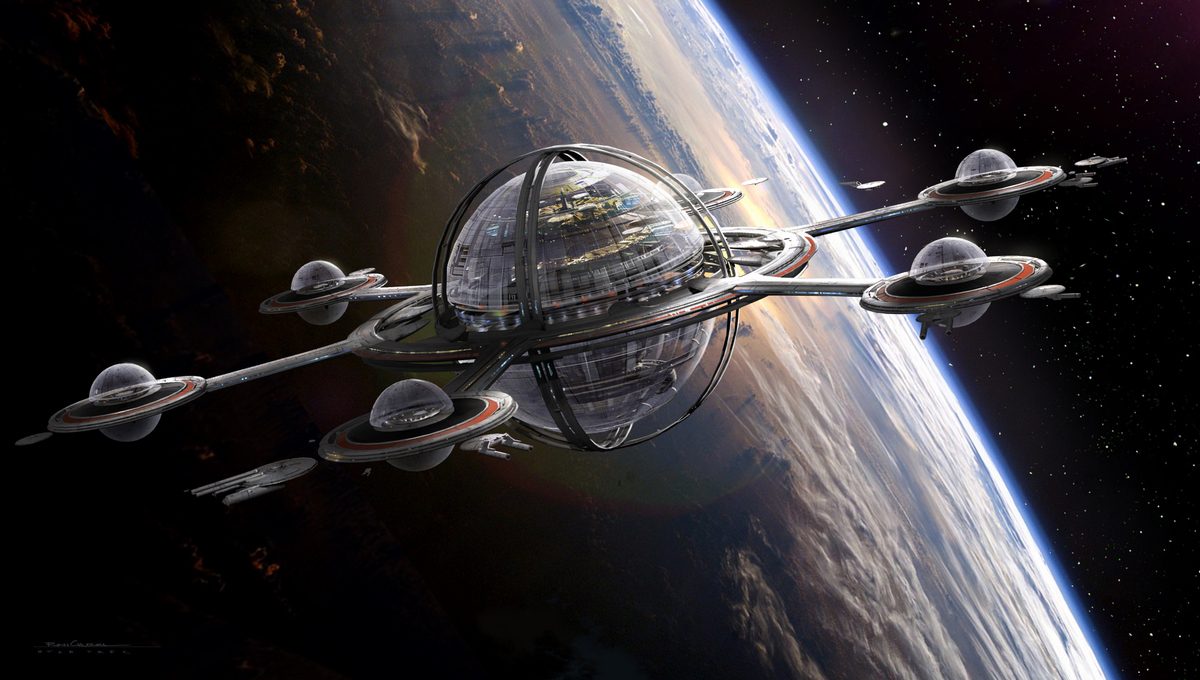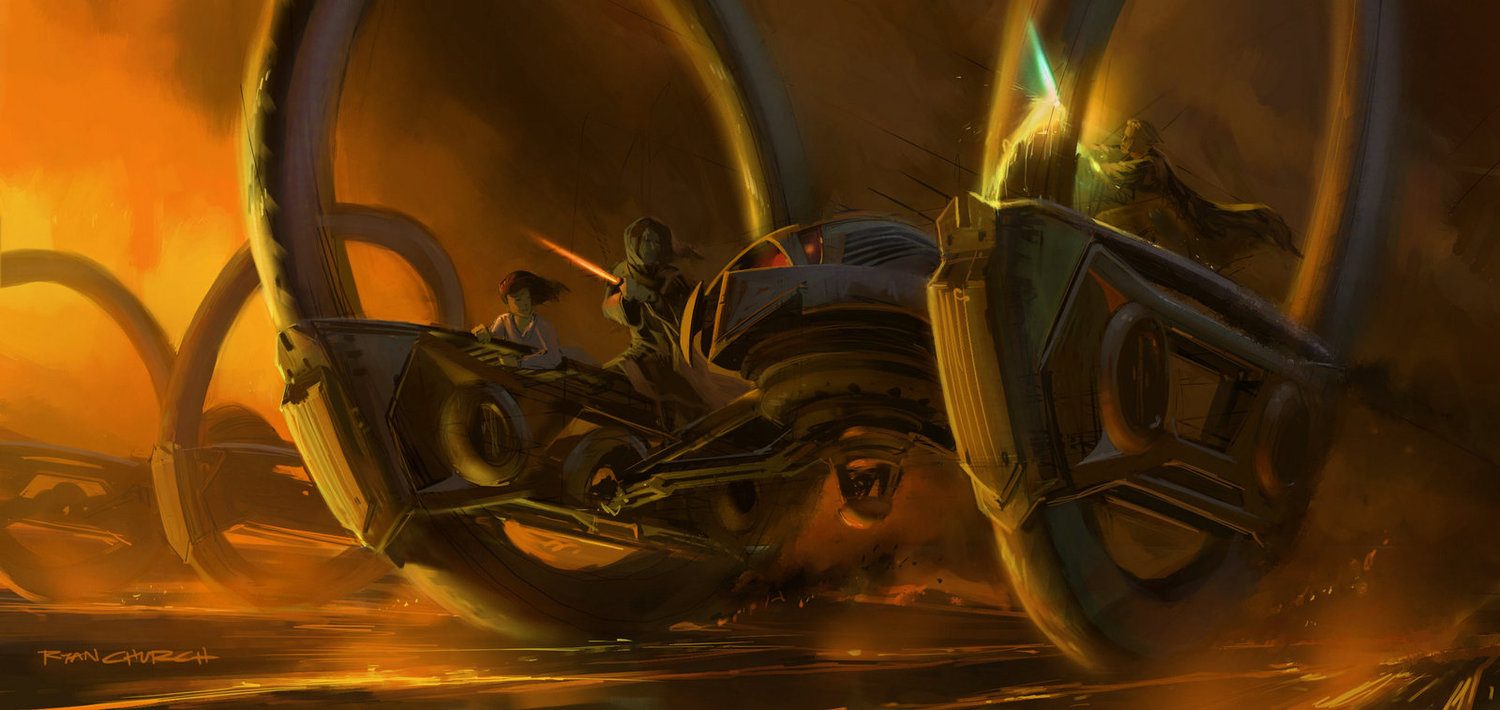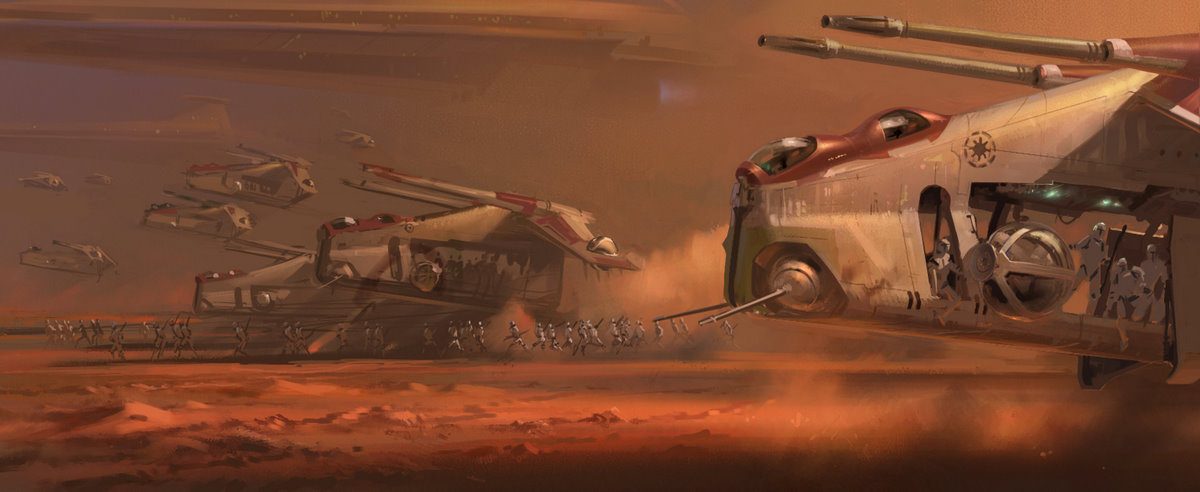We’re really happy to share with you this interview with Ryan Church, who’ll be one of our speakers at IAMAG Master Classes ‘17. Ryan Church might have worked for the last 15 years honing his professional craft, but he has spent a lifetime drawing spaceships and monsters. Ryan has been employed by many of his inspirations during the length of his career, having been part of creative teams with James Cameron, Steven Spielberg, George Lucas, Ann Druyan, and JJ Abrams.
He has concepted many film projects, including Star Wars: Attack of the Clones, Revenge of the Sith, The Force Awakens, Rogue One, and Episode VIII, War of the Worlds, Star Trek and Star Trek Into Darkness, Transformers 1–5, Avatar, Super 8, John Carter, Zero Dark Thirty, Thor: The Dark World, Cosmos: A Spacetime Journey, Tomorrowland, Godzilla, and Ready Player One. In 2010, Ryan won an ADG Award for Excellence in Production Design for Avatar.

IAMAG – I’ve read in your previous interviews that you started your art career very young, and I was wondering how you think it’s possible for people to build their artistic visions at a young age, despite the fact that as kids, we have very limited skills.
Ryan Church – Yes I’ve always loved drawing. I think most kids do really, if you put a pencil in their hands. I think the most important factor in my becoming an artist was that my father was an artist and could draw and show me how to do so, but more importantly he would show me a lot of artwork in books and things and instill in me an appreciation for how this stuff was actually created. Early on, he opened my eyes to the fact that it was created—somebody sat down and did that—and it’s easy to take it for granted with all of the imagery we have around us.
Very early, I realized that all I needed was a piece of paper and a pencil to entertain myself, to challenge myself to draw and create things I had seen, and I could communicate things that would otherwise remained trapped in my imagination; I could let all of that stuff out.

In 1/10th of a second, you can tell how good an illustration or design is; and if you are honest, you can measure yourself up against the skill levels of others very easily
IA – After graduating, you’ve worked for Disney and then at ILM. How do you think you’ve build your own style and art, and how has it evolved since, from Disney to ILM?
RC – I think I really formed my own style when I was at the Art Center College of Design; prior to that, I was just learning how to draw. Back then, it was all traditional media, and I had a rough idea of how to draw with pencil and marker and paint with gouache and acrylic. It was all just the mileage of filling up sketchbooks and getting more skills. When I went to school at the Art Center, all of a sudden I was competing on a daily basis—competing for bragging rights or the friendly back and forth you have with your schoolmates. I would compare myself with other students and try to be as good as those in my term, and then I would try and learn and be as good as somebody a term or two or four ahead of me.
That’s what I love about the visual arts, is that the skill level is instantly apparent. In 1/10th of a second, you can tell how good an illustration or design is; and if you are honest, you can measure yourself up against the skill levels of others very easily. But to answer your question—yes; prior to Art Center, I was basically just doing really bad copies of Syd Mead or Ralph McQuarrie illustrations.
When I entered a competitive environment of many talented classmates and teachers, I began to develop my own style, which is what Disney and then ILM were looking for early in my professional career.

IA: You often name artists like Syd Mead, Ralph McQuarrie and Joe Johnson as some of your inspirations. In what ways do you think they’ve influenced the industry and your own art and its process? Who are the other artists that you admire and who inspire you today?
RC – Well, I think that in the last 30 or 40 years, there are really two masters who established the looks that are still dominant today: Syd Mead and Giger. I would put McQuarrie and Johnson in the next tier simply because, like all of us, they are standing on Syd’s shoulders.
Syd was the first to so consistently and prolifically illustrate convincing, realistic, aesthetically and exotically beautiful and technically appropriate machines in a realistic-feeling fantastic environment- and he did a lot of them, over and over, always innovating and delighting with his work; just home run after home run back in the 1960s when a lot of other art of this kind was really pretty uninspired. And it is very rare to see a creature that doesn’t owe a lot to Giger. He reached deep within himself and visually distilled the nightmares of humanity to come up with some truly remarkable, beautiful, and iconic stuff.

Movies are really short! You don’t have a lot of precious screen time to slowly describe how something functions or how you should feel about it or who is in it
IA – Could you explain the main role and responsibility of a concept artist working for such iconic movies as Star Wars and Star Trek?
RC – Yes, the main role of a concept artist is to read the script, formulate an idea of the function and aesthetic of the environment, vehicle, or technology described in the script, and to come up with ideas of what it could look like, and articulate those ideas. The Director (and others!) have a lot to say about what they want to see, and above all, how the design can serve the function of the story and look appropriate in the movie. Movies are really short! You don’t have a lot of precious screen time to slowly describe how something functions or how you should feel about it or who is in it; the designs need to be instantly and strongly recognizable and help tell the story instead of cause confusion or doubt in the mind of the viewer.
This is unfortunate, as it often leads us designers into the use of clichés or a type of shorthand to convey the design. It’s why a lot of bad guy hardware is hard edged and pointy, and a lot of good guy hardware has softer shapes and a warmer feeling. I wish we had more time in movies to be a bit more realistic and to go against type and challenge notions; but that is a rare case.

IA – You’ve worked with George Lucas and JJ Abrams for Star Wars. Could you give us some details about the creative process and workflow with these Directors regarding the iterations, and how it can change your way of building worlds depending on the directors?
RC – Yes, I’ve had the fortune of working on the Star Wars movies for George Lucas and JJ Abrams. Working with George was amazing. He created these worlds and characters from nothing and changed the world with his movies. I’m a huge fan of the old Star Wars movies, and George taught me a lot about how to design something that is iconic rather than just interesting. It was a real treat to work with JJ—who I’d worked for previously on the Star Trek movies—to go back into those old ’70s and ’80s Star Wars movies and treat them as period pieces and try and distill down what made them so strong visually.
One thing that was very important for George and JJ is to really think of what you saw in the movie, not in the artwork for the movie or the video game or any other extrapolation, but to remember and study what you actually saw in the movie through the lens. That’s part of the rigor that went into the creation of Episode 7.

IA – What are, in your opinion, the most important things to focus on when, as an artist, you’re so close to the director and help him give a vision of the movie?
RC- In my opinion, the most important thing to focus on when you are in the room with the director trying to come up with what they are asking for is to really listen to what they are looking for and to remember that they have seen it all and realize that you are there to help their process of discovery along.
I’ve often had it be the case where I worked for weeks or months on a design, only at the end to circle back to something that was done very early on. This sounds frustrating but it’s not; it is all part of the process and a good director will want to make sure they have explored every option and seen every potential.

IA – You’ve worked as a concept artist and an art director. How difficult is it to be an art director as compared to a concept artist, and what are the main advantages and drawbacks of each of the positions?
RC – In the most basic terms, a concept artist works at the very beginning of the process and an Art Director works more towards the end. This is a very loose description, and in fact, the roles are always shifting; but it’s sometimes useful to think of things in those terms. As a concept artist, I go in before most of the other people on the production are hired; sometimes its’ just myself, the director and a producer or two.
Often I am generating the first artwork to work out some of the more basic design questions, and this artwork will be used to estimate the budget of the visual effects and set builds and sometimes even to get others interested in the project and get the movie funded, or to get the budget increased.
As art director, the role is more about taking the designs and getting them built, either as real sets or as CG assets, basically turning loose sketches into something real that can be put in front of the camera (or virtual camera).

IA – Thinking about John Lasseter’s famous quote “The art challenges the technology, and the technology inspires the art.” Do you think that due to the technology and the evolution of VFX, a concept artist today has more freedom when it comes to imagining complex scenes than a few years ago?
RC – I really do believe that technology has allowed today’s concept artists—and therefore directors and writers—to realize far more complex photorealistic scenes than in the past. This doesn’t always result in better storytelling though! I was raised during the heyday and the pinnacle of practical effects during the 70s and 80s; it is very tough to improve on the stories from those times, though film as a medium is very susceptible to locking itself in a specific time period. The masterworks are the ones that feel timeless and advanced even today. Movies like 2001, Star Wars, THX-1138 and Blade Runner still feel incredibly fresh; if not for their hairstyles and slower editing, they are incredibly modern.
IA – To follow up my previous question, what’s your own experience of the evolution of the technology in your art?
RC – I started in the age of traditional art—pens, paper, markers, paint—and used those tools up through my schooling and into an early professional career. I learned to use the computer to create art while on the job. Early on in my career, I would try and bend the computer—then much slower and less powerful—into an art machine, emulating traditional techniques. But before that, I was able to draw and paint using only paper and a few pens or brushes. So I was able to use the computer as just another tool and I still look at it that way. I love that the computer now allows me to think more about the design and the cinematic presentation than having to plot perspective or depict a conservative design, because of the time needed to create it. The computer allows more iteration, which as a designer, I love.

Working in a film is really an exercise in trickery and iconography, because in the end, the design will only be seen on a flat screen at the exact angle that the director chooses
IA – You’ve worked for the video game industry as well for the movie industry. Can you tell us how different it is or is not to create art for these two kinds of industries? How are the challenges different?
RC -Working on movies and games is pretty similar, but there are a few big and important differences. What I really like about game design is the fact that it is closest to designing something ‘real’—it will be seen from all angles. It will often be used and interacted with so there is the importance of ergonomic considerations, and it will often be seen for a long period of time.
Working in a film is really an exercise in trickery and iconography, because in the end, the design will only be seen on a flat screen at the exact angle that the director chooses, and will often only be seen for a second or two, which is enough time to establish the design and get it out of the way of the story. You can see why this makes designing for games so satisfying in comparison! I really do enjoy it; it lets me, as a designer, to really get into a set or prop or vehicle and think about it in the same way a real designer would.

IA – We previously discussed about the artists you respect and like. If you were to reinterpret a famous painting or a piece of art, what would it be and why?
RC – Hmm… I’ve never had this question before, and this is probably a really dumb and pretentious answer, but I’d love to be in a world where I could work on an opera or something. I love music and I think that is one artistic aspect that I know nothing about but I really like, and it would be fun to collaborate in a project where that was part of the initial consideration. I’m very picky with the music I like though, so it would have to be something exactly right, something I could get into.
IA – You have in the past shared your creative process through a Gnomon DVD. What have you learned from such an experience and what do you think the public can learn from your creative process?
RC – Yes, I have done Gnomon DVDs and I have taught at the Art Center as well. I have also done talks and demos for schools and groups. What all of this does is force you to sit down and analyze your process which has made me better. In order to distil a workflow down, and be able to communicate it, I have to self-analyze in a way that I think helps when I get stuck in a creative situation or find myself in a rut.
And of course, the real benefit is getting interaction and feedback from other people—students and fellow professionals—that we can share our process, hopes and stuff that bums us out, and keep improving and remembering how much fun it is to do what we do.

IA – You will, in March ’17, during the IAMAG Master Classes, share with our attendees some of your works. What’s your experience about sharing knowledge, experience and art with the public? Do you have an idea of what you’ll share with us?
RC – Yes, as I was stating above, I really love this type of event; getting together and sharing what I’ve learned and my misadventures along the way. In our time together, I look forward to doing not only that but being able to answer tough questions about technique, workflow or problem solving, and above all, to hopefully inspire people to pursue these paths because I can tell you from first-hand experience how much fun they are!
[rev_slider alias=”content-tabs”][/rev_slider]


